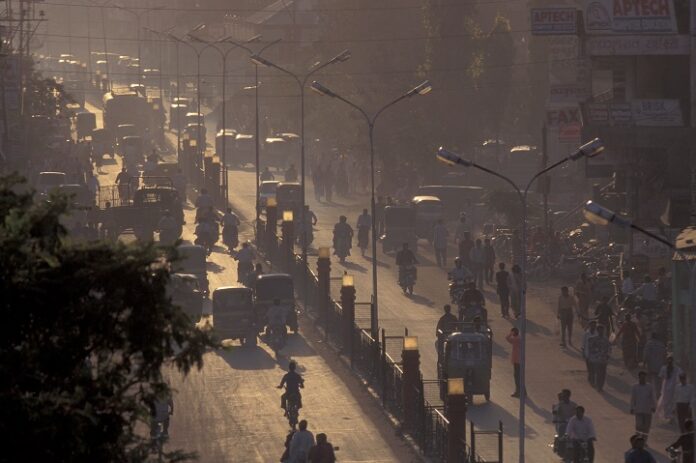India’s economic activity remained healthy during the first half of the current fiscal year. Over the 2023/2024 full year, it is expected to be close to 7%, boosted mainly by sustained private and public investment. The rise in the investment rate for the second year in a row is particularly beneficial, as it addresses one of the country’s structural fragilities. Up until now, the constraints on production factors (both labour and capital) and the country’s lack of integration into global trade have made it less appealing, as evidenced by the further drop in FDI flows (-0.9% of GDP) over the first three quarters of 2023. However, the moderate current account deficit and large foreign exchange reserves are reducing the downward pressures on the rupee.
Robust economic activity
Over the first six months of the fiscal year (FY) 2023/2024 (April-September 2023), economic activity remained healthy in India. Real GDP was up 7.7% from the same period in FY2022/2023. Skyrocketing investment (+9.5%) more than offset net exports’ dwindling contribution to growth.
Despite the expected slowdown during the second half of the current fiscal year, growth over the entire 2023/2024 year could hit 7.3% according to the Indian National Statistical Office (NSO). This is 0.3 pp higher than the level anticipated by the Reserve Bank of India (RBI) and 1 pp above the forecasts published in January 2024 by the World Bank.
Economic growth for 2024/2025 is expected to slow due to a combination of fading internal demand driven by monetary tightening, and weakening external demand. Over the period from April 2022 to December 2023, the hike in key policy rates (+250 bp) resulted in an increase in average rates on new loans of 183 bp (+469 bp in real terms).
Risks to growth
Three main risks can be identified. First of all is the climate, which has a bearing on harvest levels. Due to El Niño, the rain levels in the 2023 monsoon season were 6.5% lower than normal across the entire country, but there were still very substantial disparities between regions. Even though there was an overall slight rise in the numbers of kharif crops planted compared to normal, this was still well down from the previous year. In addition, El Niño could increase temperatures in Q1 2024 and adversely affect the current year’s crops. The Ministry of Agriculture & Farmers’ Welfare currently estimates that grain harvests could be less than half of the previous year’s. Poor harvests would, on the one hand, adversely affect raw material prices (and therefore household purchasing power) and, on the other hand, farmers’ incomes. This is important, as the agricultural sector alone accounted for 42.9% of employment in 2022.
The second risk, which is contingent on the first risk, relates to monetary policy against the backdrop of re-emerging inflationary pressures. During the final two months of 2023, inflationary pressures intensified, hitting 5.6% on average, fuelled by rising food prices (which make up 45.9% of the household consumption basket). However, price rises remained below the target set by the monetary authorities (4% +/-2 pp) and core inflation (excluding food and energy prices) continued to ease, falling to +3.9% y/y in December. The RBI is therefore expected to keep its key policy rates unchanged during the upcoming Monetary Policy Committee meetings. However, if food prices were to remain firmly stuck at high levels, this could delay the monetary easing expected in Q4 2024.
The third risk is linked to the international environment. There are high geopolitical risks to global growth and any downward revision of global growth by 1 pp would lead to a drop in Indian growth of 50 bp. In addition, India is still vulnerable to oil-price rises, even though this risk is much milder than before, as the country now buys more than 35.3% of its oil from Russia at a lower price than that paid to its suppliers in the Middle East.
Over the next five years, economic growth is expected to remain robust (between 6 and 6.5%), but the growth rate is expected to be lower than the one recorded over the past ten years (+7% over the 2010-2019 period). However, growth could become more dynamic if the investment rate continues on its upward trajectory and provided that, in addition, (i) the labour market is liberalised more effectively and (ii) women’s participation rate increases.
Sustained domestic investment activity…
The major structural constraints on India’s development and appeal are infrastructure and equipment deficiencies, which reflect a lack of investment to meet the country’s needs. Nevertheless, the investment rate (in volume) has hit 31.8% of GDP over the past decade, which is ahead of other Asian countries. However, almost 40% of the investments were made by households, mainly in their housing. Government investment in infrastructure accounted for just 9.4% of the total investment, and investment in machinery and capital goods made up only 25.4% of the total investment.
Nevertheless, for nearly two years, private and public investments have accelerated substantially, especially because banks’ and companies’ financial positions have strengthened. In 2022/2023, the investment rate rose by 1.3 pp to hit 34% of GDP, a level which had not been seen since 2013, and this positive trend continued during the first half of FY2023/2024. It is also likely to resume during the third quarter of the current fiscal year, in view of the business lending indicators and the production capacity utilisation rates rising above their long-term average. Furthermore, in its 2023/2024 budget, the government had in particular set out to increase its infrastructure investments by 0.6 pp to 3.3% of GDP (which had already risen by 1.1 pp over the previous three years). In view of the expenditure over the first eight months of the fiscal year, the government is seemingly managing to achieve its target, as its investments are up nearly 31% on the same period last year. The NSO forecasts that the investment rate could stand at 34.9% of GDP this year, a level never seen before.
In FY2024/2025, while public investment is expected to continue to strengthen, growth in private investment is expected to slow at least temporarily, as the interest rate hike and April/May 2024 elections will delay some projects.
… but stubbornly low FDI
Over the first three quarters of 2023, the current account deficit plummeted to just 0.7% of GDP, compared to 2.5% of GDP over the same period in 2022. However, foreign direct investments (FDI) were not enough to offset this low current account deficit. India is still strongly dependent on portfolio investments and this will increase with Indian sovereign bonds being integrated into emerging indices at the end of June 2024. At the same time, there are still large foreign exchange reserves (standing at USD 546 billion at the start of January), which are more than adequate to cover the country’s short-term financing needs and help the RBI to contain the depreciation of its currency.
Already low, FDI declined further over the first three quarters of 2023 and only stood at 0.4% of GDP (compared to 1.3% of GDP in 2022). This drop in investment in the run-up to an election is “normal”, but it is happening even though FDI relative to GDP has been dwindling since 2021. In addition, FDI inflows in India are still particularly low compared to flows to other emerging countries, despite government measures to attract them. According to data published by UNCTAD, in 2022, India only received 5.7% of FDI for emerging markets, compared to an average of 7.1% over the 2016-2020 period. By comparison, the share of FDI to China stood at 20.6%. The low FDI to India stems not only from the structural constraints on its economy (insufficient infrastructure, a very low women’s participation rate, a high youth unemployment rate, a lack of skilled labour in industry and red tape), but also from its lack of integration into global trade. In 2018, the OECD estimated that its participation rate in global value chains (which is slightly lower than Indonesia, which also receives little FDI) was just 36.4%, compared to 55.1% in Malaysia and 62.1% in Vietnam.
India’s market share in global trade is still small and has not increased a great deal over the past decade. In 2022, India’s exports of goods and services only accounted for 1.9% and 4.3% of global exports, respectively, compared to 1.6% and 3.2% in 2012. For comparison purposes, China’s market share for goods exports was 14.7%.
India’s lack of integration into global trade is mainly due to its much more protectionist trade policy than other Asian countries, and there are still major tariff and non-tariff trade barriers with the country. According to the WTO, the average rate of customs tariffs imposed by India on imports from partner countries is 18.1%, compared to just 8% in Indonesia and 2.3% in China. In addition, over the past decade, India’s customs duties have risen (+3.7 pp) while other countries in the world have fallen (-0.6 pp). Finally, India has signed few trade agreements compared to other countries in Asia.
Article completed on 25 January 2024
Source link






